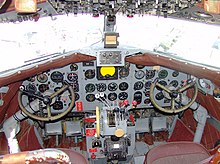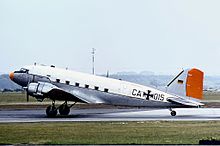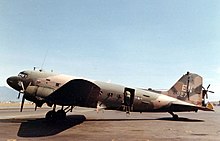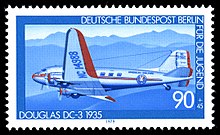Douglas DC-3
| Douglas DC-3 / C-47 | |
|---|---|
 Douglas DC-3 over Stockholm , 1989 |
|
| Type: | Passenger and transport aircraft |
| Design country: | |
| Manufacturer: | |
| First flight: |
December 17, 1935 |
| Commissioning: |
1936 |
| Production time: |
1936 to 1945 |
| Number of pieces: |
16,079 (10,655 Douglas, 5,424 licensed buildings) |
The Douglas DC-3 ( Douglas C-47 and Douglas Dakota as military version ) is a type of aircraft of the Douglas Aircraft Company , 10,655 copies in the original and in 5,424 copies built under license, some of which are still used commercially today. A total of 16,079 units (607 civil and 15,472 military machines) were produced; to date the highest number for a passenger or transport aircraft. The military versions Douglas C-47 ( US Air Force ) and Douglas Dakota ( Royal Air Force ) became known in Germany as one of the aircraft types nicknamed " Raisin Bomber " during the Berlin Airlift .
history
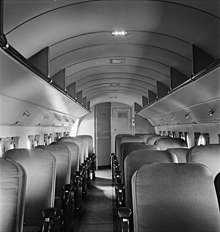
The DC-3 is a further development of the DC-1 , of which only a prototype was built. This prototype had its maiden flight on July 1, 1933 and was so promising that it was immediately upgraded to the DC-2 , which was larger and more powerful than the DC-1. It was important for Douglas to compete with the Boeing 247 . 193 Douglas DC-2 aircraft were manufactured.
The Douglas DC-3 was originally designed to allow passengers to sleep while in flight. To ensure this, loungers were initially built into the DC-3. This system was initially called DST (Douglas Sleeper Transport). After seats were reinstalled in the DST, the aircraft got its name: Douglas DC-3. The passenger capacity was initially 28, later up to 35 passengers .
The DC-3 had its maiden flight on December 17, 1935 from Santa Monica ( California ) airfield . The aircraft was characterized primarily by its safety, robustness and high economic efficiency. During the Second World War , the DC-3 was used as a transporter, tow plane, ambulance aircraft and passenger aircraft. It had many names and designations in the American armed forces: C-41, C-47, C-48, C-49, C-50, C-51, C-52, C-53, C-68, C-84 , C-117, Skytrain or Skytrooper ; in the US Navy it was called R4D. In the Royal Air Force , the aircraft was used under the name "Dakota".
There was an experimental version with floats and one with removed engines as a cargo glider Douglas XCG-17 . The freight version had a wide double-leaf loading door to make loading and unloading easier. Around 500,000 rivets were used to assemble an aircraft .
After the Second World War, some of the aircraft used by the United States Army Air Forces were sold to civil aviation companies. The DC-3 thus played a role in the development of civil aviation that should not be underestimated. A slightly more stretched version, the DC-3S or Super DC-3 with more powerful engines, first flew in July 1949. Some of these machines were built as the R4D-8 for the US Navy. Today only a few of them are airworthy and in use.
In Germany, three copies of the DC-3 were used by Lufthansa after the war , initially from October 1955 in German domestic feeder traffic, later in freight service. Two of them then went to Bavaria , which also used a third. The short-lived Deutsche Lufttransport Gesellschaft mbH used a DC-3 from August 1955 to 1956. Finally, the Nordseeflug Sylter Lufttransport also used a DC-3 (D-CNSF) from August 1966 to May 1968.
DC-3s that are still in use today have been partially retrofitted with more modern turboprop engines (PTL), which has improved their performance and economy somewhat. Externally, they can be recognized in part by features such as the extended engine cowling, five-blade propellers or noticeably large exhaust pipes.
The only DC-3s still in regular service today fly on the Yellowknife to Hay River route in the Northwest Territories of Canada operated by Buffalo Airways . In addition, a DC-3 flies tourists to the Masai Mara National Park almost every day from the Kenyan provincial airport Ukunda. The New Zealand regional airline Air Chathams operates them on the Auckland - Whakatane route.
In Colombia, the DC-3 (2011) is also used both for supplying and for passenger transport to and from remote villages on the Amazon. The planes are the only connection to the outside world there.
Since March 2017 (shortly before completion in September in Vienna) the Breitling DC-3 (with the first flight of the copy in March 1940) with the registration HB-IRJ , with pilot and owner (since 2008) Francisco Agullo, flew eastwards around the world. The aircraft is 77 years old, making it the oldest aircraft to circumnavigate the world. Due to the lack of a pressurized cabin, it is not possible to climb high, and to prevent icing in the troposphere , the flight altitude was reduced to 600 or even 300 m over the Pacific. On the other hand, a pressurized cabin would limit the life of an aircraft. For this trip, additional tanks were installed and fuel was brought to intermediate stops, for example to the US air force base on the Aleutian island of Shemya off Alaska.
Licensed buildings
The DC-3 was (1942 in 1938 to 1954 under the name PS-84 Lisunov Li-2 changed Codename Cab ) in the USSR in license made. However, it was equipped with Soviet М-62IR engines , which only produced 1000 hp, and got shortened wings (wingspan 28.81 m compared to 29.98 m). The changes were reflected in the top speed, which at 322 km / h was significantly lower than that of the DC-3; due to economical engines, the range of the PS-84 / Li-2 was 2600 km instead of the 2160 km of the DC-3. For the transfer of the construction to the Soviet license production, all dimensions and screw connections were transferred from the imperial to the metric system of measurements.
A total of 4937 Soviet copies were completed in various variations, in addition to the one for passengers, among other things as VHF transmission station and as a tug for gliders and in military versions as bombers , fighter-bombers, hospital aircraft . The last airworthy Li-2 in the Russian Federation , the № 23441605, which was used at flight events, crashed in 2004 near Moscow .
Even Japan acquired a license of Douglas. From 1940 to 1945 Nakajima Hikōki produced together with Shōwa Hikōki Kōgyō 487 pieces with the designation L2D ( allied code name like the DC-3 tabby ). The variants differed with differently strong engines, the interior design, whether as transport machines for loads or people and the armament. Depending on the version, after L2Dxx there was a different number or letter in the fourth or fifth position. As in the Soviet Union, the airplane was not completely faithfully reproduced in Japan, but changed; the engines were also replaced by designs from our own production ( Mitsubishi-Kinsei ).
Basler BT-67 with turboprop engines
Japanese license version Nakajima L2D
Soviet license version Lissunow Li-2
Heavily modified DC-3 with FLIR under the fuselage
C-117D of the US Marine Corps with enlarged vertical stabilizer and landing gear doors
Civil versions
Post-war buildings
DC-3C
After the end of the war, Douglas manufactured or converted 21 DC-3Cs from existing components and former USAF aircraft. These were given new serial numbers from 43073 to 43092 and 43154 and were sold to civilian customers, both to airlines and to companies or private individuals. The Belgian Sabena received seven of these new aircraft, the US Waterman Airlines three and Pacific Northern Airlines one. The deliveries took place from July 1946 to March 1947.
Later the designation DC-3C was also applied to other civil conversions, often uncoordinated, but no new serial numbers were assigned.
DC-3D
From remaining parts for some non-built C-47s and completely overhauled military machines, 28 brand-new DC-3Ds were built, also at Douglas. They received the serial numbers 42954 to 42981 and were mainly sold to airlines between February and May 1946:
- 2 to Aer Lingus
- 4 to Air France
- 3 to Det Danske Luftfartselskab, DDL
- 2 to NAB - Navegação Aérea Brasileira
- 2 to Swissair
- 3 to Sabena
- 1 to KLM West-Indisch Bedrijf
- 5 to Colonial Airlines (USA)
- 3 to Pacific Northern Airlines (USA)
The remaining three went to companies and the Royal Netherlands East Indies Army Military Air Service.
DC-3S (Super DC-3)
In 1949 a stretched version with angular wing tips, a new bow and modified rear fuselage and tail unit was presented. Since the market was flooded with hundreds of formerly military DC-3s, only three machines could be sold to Capital Airlines (serial numbers 43191 to 43193). One of the other two built was used as a prototype for the C-117D. The US Navy then ordered 100 conversions from used aircraft and designated them as R4D-8 (from 1962 also renamed C-117D). They were delivered from 1951 to August 1953.
Douglas C-47 Skytrain
The C-47 and C-53 were the newly built military versions of the DC-3. They were delivered to the troops from December 1941. The C-47 was the workhorse of the Allied transport aircraft in World War II, and its production totaled 9,583 units. Well-known missions were, for example, Operation Overlord (landing in Normandy, 820 planes deployed), Operation Husky (Allied invasion of Sicily) and Operation Market Garden (advance on Arnhem and Nijmegen), in which 1550 Skytrains and Dakotas were involved. Operations in which the C-47 was also used were, among other things, Operation Dragoon (landing on the Côte d'Azur) with 396 participating C-47 / C-53 and the long-standing difficult supply route to Southeast Asia via The Hump ("The hump") designated Himalaya. It often dwarfed the Curtiss C-46 in public , but it performed better in almost all areas. The exact names of the most important versions were:

- C-41A: Military DC-3A for testing (single item), purchased by the Army Air Corps in August 1939.
- C-47-DL: First military series version (built 965), including larger wingspan.
- C-47A-DL / DK: Largest series (5,254 units), the difference to the previous version was a 24-volt system.
- C-47B-DL / DK: Many detail improvements, better height performance. 3,364 machines were produced.
- C-53-DO Skytrooper : Version for troop transport with 28 fixed metal seats and without cargo door. 219 built.
- C-53B : DC-3A-405 with larger tank, Astrodome and winter equipment. 9 rebuilt.
- C-53C: DC-3A-453 with 28 seats and a 76 cm wide door on the port side. 17 built.
- C-53D-DO: Further development of the C-53-DO. The main feature were the now laterally attached seats. 159 built.
The above versions were just a few of the many different military versions of the DC-3. During the war in May 1942, 92 DC-3s and DSTs that were already in use there were bought or requisitioned by civil airlines. Even before they were delivered to civilian customers, 108 brand-new machines were requisitioned. Depending on the version, they were given the designations C-48 (11 pieces), C-49 (75), C-50 (14), C-51 (1), C-52 (5) and C-68 (2).
After the war, numerous C-47s were retired; many flew around the world for a long time, including Europe, and even longer in third world countries .
After the end of the war, Douglas built 28 brand-new DC-3Ds for civilian operators from the as yet unfinished C-47 and C-117.
Douglas AC-47 Spooky

Even before the AC-47 Spooky , a modified version of the C-47D was given the designation AC-47D in 1953: it was used to measure radio beacons. They were renamed EC-47D in 1962.
During the Vietnam War , C-47s (in addition to their traditional transport role) were heavily armed and used as " gunships ". During the war, the US Air Force came to the conclusion that a fighter aircraft capable of firing massively and concentratedly on relatively small enemy areas on the ground was a potentially decisive weapon.
The first aircraft of this type was the "Gunship-I" development of the C-47D, which was originally called the FC-47D and was later called the AC-47D "Spooky" . It was a comparatively simple modification of the underlying transport aircraft , which was armed with three 7.62 mm XM134 machine guns in SUU 11A weapon containers and 24,000 rounds of ammunition. The weapons were installed on the left side of the aircraft (in the fifth and sixth windows as well as on the cargo hatch) and at the highest rate of fire (6000 rounds / minute each) could put a bullet into every square foot (30 × 30 cm) of a football field within three minutes shoot.
The tactic was to fly an even left circle around the target so that the pilot could aim and fire the weapons, the ammunition of which was reloaded by weapons control rooms, which also emitted flares during night missions.
A total of 53 C-47Ds were converted to AC-47D; From November 1965, 16 aircraft were in service with the 4th Air Commando Squadron (ACS, roughly "Command Squadron") of the 14th Air Commando Wing (command squadron), four more aircraft were available as replacement aircraft. The squadron was stationed at Tan-Son-Nhat Air Force Base , but the aircraft also operated from Bien Hoa , Pleiku , Nha Trang , Da Nang and Can Tho . The successful deployment led to the formation of two more squadrons, the 3rd and 5th ACS. In August 1968 the designation "Air Commando" was abolished and the ACS became Special Operations Squadron (SOS, squadron for special operations).
In total, 41 of the 53 converted AC-47Ds were used in the Vietnam War. Between December 1965 and September 1969 the USAF lost 19 AC-47Ds, 12 of which were shot down. The rest were then handed over to the South Vietnamese Air Force (VNAF) and some to Laos as part of the “Vietnamization” .
The El Salvador Air Force also owned AC-47D from the US Air Force and used it during the Civil War (1980 to 1992) , among other things .
Armament AC-47
- 3 × SUU-11A weapon containers on mounts each with 1 × six-barreled 7.62 mm Gatling machine gun General Electric M134 "Minigun" with 8000 rounds of ammunition each
Conversion to propeller turbines
The company Basler Turbo Conversions of Oshkosh (Wisconsin) offers under the name BT-67 one on propeller turbines of the type Pratt & Whitney Canada PT6 to upgraded A-67R version of the DC-third At the same time, the fuselage will be lengthened, the fuselage structure reinforced and the control systems and avionics renewed. This creates a practically new aircraft. Since the original machines did not have a pressurized cabin, they were only slightly exposed to material fatigue.
One of the users is the German Alfred Wegener Institute for Polar and Marine Research , which uses two BT-67 (Polar-5 / Polar-6) in polar research , also because the DC-3 is one of the few machines in this weight class that have an approved combined ski and bicycle chassis.
Military production
Acceptance of the C-41, C-47 to C-53, C-68 and C-117 by the USAAF:
| Manufacturer | Type | 1938 | 1939 | 1940 | 1941 | 1942 | 1943 | 1944 | 1945 | TOTAL |
|---|---|---|---|---|---|---|---|---|---|---|
| Douglas, Santa Monica | C-41 | 1 | 1 | |||||||
| Douglas, Santa Monica | C-41A | 1 | 1 | |||||||
| Douglas, Long Beach | C-47 | 800 | 230 | 1,031 | ||||||
| Douglas, Long Beach | C-47A | 1,717 | 1,237 | 2,954 | ||||||
| Douglas, Oklahoma | C-47A | 465 | 1,834 | 2,299 | ||||||
| Douglas, Long Beach | C-47B | 300 | 300 | |||||||
| Douglas, Oklahoma | C-47B | 1,529 | 1,536 | 3,065 | ||||||
| Douglas, Long Beach | XC-47C | 1 | 1 | |||||||
| Douglas, Santa Monica | C-48 | 1 | 1 | |||||||
| Douglas, Santa Monica | C-48A | 3 | 3 | |||||||
| Douglas, Santa Monica | C-49 | 6th | 6th | |||||||
| Douglas, Santa Monica | C-49A | 1 | 1 | |||||||
| Douglas, Santa Monica | C-49B | 3 | 3 | |||||||
| Douglas, Santa Monica | C-49C | 2 | 2 | |||||||
| Douglas, Santa Monica | C-49D | 5 | 5 | |||||||
| Douglas, Santa Monica | C-49J | 26th | 8th | 34 | ||||||
| Douglas, Santa Monica | C-49K | 13 | 10 | 23 | ||||||
| Douglas, Santa Monica | C-50 | 4th | 4th | |||||||
| Douglas, Santa Monica | C-50A | 2 | 2 | |||||||
| Douglas, Santa Monica | C-50B | 3 | 3 | |||||||
| Douglas, Santa Monica | C-50C | 1 | 1 | |||||||
| Douglas, Santa Monica | C-50D | 4th | 4th | |||||||
| Douglas, Santa Monica | C-51 | 1 | 1 | |||||||
| Douglas, Santa Monica | C-52 | 1 | 1 | |||||||
| Douglas, Santa Monica | C-52A | 1 | 1 | |||||||
| Douglas, Santa Monica | C-52B | 2 | 2 | |||||||
| Douglas, Santa Monica | C-52C | 1 | 1 | |||||||
| Douglas, Santa Monica | C-53 | 25th | 188 | 213 | ||||||
| Douglas, Santa Monica | C-53A | 1 | 1 | |||||||
| Douglas, Santa Monica | C-53B | 8th | 1 | |||||||
| Douglas, Santa Monica | C-53C | 17th | 17th | |||||||
| Douglas, Santa Monica | C-53D | 159 | 159 | |||||||
| Douglas, Santa Monica | C-68 | 2 | 2 | |||||||
| Douglas, Oklahoma | C-117A | 17th | 17th | |||||||
| Douglas, Long Beach | R4D-1 | 69 | 69 | |||||||
| Douglas, Santa Monica | R4D-2 | 2 | 2 | |||||||
| Douglas, Santa Monica | R4D-4 | 4th | 6th | 10 | ||||||
| TOTAL | 1 | 1 | 1 | 78 | 1,117 | 2,596 | 4,900 | 1,553 | 10,247 |
Civil production
Deliveries of the DC-3
| Manufacturer | Type | 1936 | 1937 | 1938 | 1939 | 1940 | 1941 | 1942 | 1943 | 1946 | TOTAL |
|---|---|---|---|---|---|---|---|---|---|---|---|
| Douglas, Santa Monica | DST | 8th | 11 | 2 | 2 | 11 | 4th | 38 | |||
| Douglas, Santa Monica | DC-3 | 16 | 63 | 28 | 57 | 71 | 36 | 271 | |||
| Douglas, Santa Monica | DC-3A | 7th | 18th | 13 | 10 | 31 | 29 | 2 | 2 | 112 | |
| Douglas, Santa Monica | DC-3B | 8th | 2 | 10 | |||||||
| Douglas, Oklahoma | DC-3D | 28 | 28 | ||||||||
| TOTAL | 31 | 100 | 45 | 69 | 113 | 69 | 2 | 2 | 28 | 459 |
Incidents
From the first flight in 1935 to February 2019, the Douglas DC-3 suffered a very high number of total write-offs, most of them in connection with military conflicts.
Technical specifications
| Parameter | Data of the C-47 |
|---|---|
| length | 19.66 m |
| span | 29.98 m |
| height | 5.16 m |
| Wing area | 91.7 m² |
| drive | two double radial engines Pratt & Whitney R- 1830-92 Twin Wasp with 1,200 HP each |
| Top speed | 368 km / h at an altitude of 2680 m |
| Cruising speed | 280 to 297 km / h |
| Normal range | 2160 km |
| crew | two to four |
| Service ceiling | 7350 m |
| Empty mass | 7700 kg |
| Flight mass | 13,190 kg |
See also
- C-47 wreck in Kaş Bay
- Plane crash on the Gauli Glacier ( 1946 Switzerland )
- Catalina affair (shot down over the Baltic Sea)
- Douglas XCG-17
- Basler BT-67
- Lisunov Li-2
- Curtiss C-46
- List of the most popular aircraft
- List of aircraft types
literature
- Karl-Heinz Eyermann, Wolf S. Zedlitz: Douglas DC-3 / Lisunow Li-2. Berlin (East) 1966 (= illustrated series for type collectors, 21).
- Jennifer M. Gradidge: The Douglas DC-1 / DC-2 / DC-3 - The First Seventy Years. 3 vol., Tonbridge, Kent, UK: Air-Britain (Historians), 2006. (English)
- Henry Holden: The Douglas DC-3. o. O. 1971 (English)
- Bruce McAllister: DC-3 A Legend in Her Time. A 75th Anniversary Photographic Tribute. Chicago 2010. (English)
- Arthur Pearcy: The Dakota. o. O. 1972. (English)
- Arthur Pearcy: A Celebration of the DC-3. o. O. 1995. (English)
- Boleslaw Szuman, Jacek Konczak: Li-2. Warsaw 1976. (Polish)
- Bart van der Klaauw: De Geschiedenis van de DC-3 Dakota. Rotterdam 1979. (Dutch)
swell
on C-47 : Classics of Aviation, issue 1/2011, p. 53 ff., Karl Schwartz, Motorpresse.
Web links
Individual evidence
- ^ Rene J. Francillon: McDonnell Douglas Aircraft Since 1920 . Putnam, 1988, ISBN 978-0-85177-827-3 , pp. 217-251 .
- ↑ Pictures of the N34 on Commons
- ↑ Gradidge 2006, p. 11.
- ↑ Article about the DC-3 in the Süddeutsche Zeitung
- ^ The history of Deutsche Lufthansa, 3rd edition, Lufthansa 1984, p. 90
- ↑ Gradidge 2006 S. 185th
- ^ Buffalo Airways: Your passage to the North. - Passenger Service. In: www.buffaloairways.com. Retrieved June 16, 2016 .
- ^ Air Chathams website
- ↑ risking it all: The daredevil pilots of Colombia. Al Jazeera, June 2, 2011, http://aljazeera.com/programmes/riskingitall/2011/05/201151112305049621.html . Retrieved June 5, 2011
- ↑ "Airplane Oldtimer" circumnavigates the world orf.at September 8, accessed on September 9, 2017.
- ↑ a b Gradidge 2006, p. 20.
- ↑ http://www.airliners.net/search/photo.search?cnsearch=23441605
- ^ ER Johnson, Lloyd S. Jones in: American Military Transport Aircraft Since 1925. McFarland Inc., Jefferson, North Carolina USA 2013, ISBN 978-0-7864-6269-8 , p. 80.
- ↑ Gradidge 2006, pp 633-634.
- ↑ Gradidge 2006 S. 632nd
- ↑ Gradidge 2006, p. 15
- ↑ Gradidge 2006 S. 634th
- ↑ Gradidge 2006, p. 32.
- ↑ Gradidge 2006, p. 33.
- ↑ Chris Hobson: Vietnam Air Losses. USAF / USN / USMC. Fixed-Wing Aircraft Losses in Southeast Asia 1961–1973. Specialty Press, North Branch, Minnesota 2001, ISBN 1-85780-115-6 .
- ↑ www.nationalmuseum.af.mil ( Memento from October 11, 2014 in the Internet Archive )
- ↑ baslerturbo.com: Specifications , accessed on August 5, 2009
- ↑ Polar aircraft at the Alfred Wegener Institute - Hightech over the ice ( memento from October 20, 2011 in the Internet Archive ), accessed on August 18, 2019
- ↑ Statistical Digest of the USAF 1946, pp. 100 ff .; www.uswarplanes.net; Gradidge, Jennifer: DC-1 DC-2 DC-3. The First Seventy Years, 2nd edition Tonbridge 2010, 2 volumes
- ↑ Gradidge, Jennifer: DC-1 DC-2 DC-third The First Seventy Years, 2nd edition Tonbridge 2010, 2 volumes

